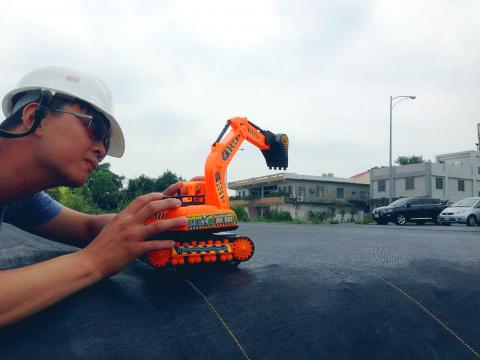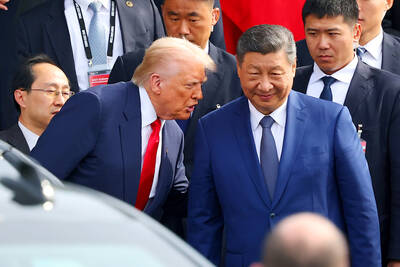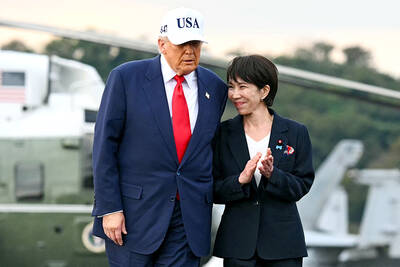Democratic Progressive Party Legislator Wu Yi-chen (吳宜臻), along with several Hakka activists, yesterday urged the Miaoli County Government to halt a project to build a tourist information center outside the planned high-speed rail station in Houlong Township (後龍), saying that its chosen architectural style has no cultural connection to Hakkas living in Miaoli.
In order to leave an impression of Hakka culture on travelers arriving at the station, the county government plans to build a tourist information center in front of the station in the tulou style (土樓) — a traditional fortress-like communal residence found in mountainous regions in the southern parts of China’s Fujian Province.
While tulou architecture is not uniquely Hakka, the architectural style is considered Hakka by many, since most remaining tulou are found in Hakka villages.

Photo courtesy of Chien Hung-wei
However, for Hakkas in Taiwan, the architectural style is as foreign as it is to many non-Hakkas.
“Chinese tulou have no cultural or historical connection to Taiwanese Hakkas, [a tulou in Miaoli] is like something that fell from the sky — it doesn’t belong to Taiwan or Miaoli,” Ceng Nian-you [曾年有], a Miaoli-based Hakka culture and history researcher, told a press conference at the Legislative Yuan in Taipei yesterday. “We have our own culture in Miaoli, why is the county government not using local cultural elements for the tourist information center?”
He said that for local Hakkas, the traditional residential building is a huofang (夥房) — literally “communal house” in Hakka — which has a square layout, with a courtyard in the middle for agricultural activities such as sun-drying rice or vegetables, or for banquets, and a hall for religious use.
“I don’t understand why the county government had to tear down century-old kilns that once stood on the site of the high-speed rail development, and replace them with something that has no local connection,” Ceng added.
Chern Ban (陳板), a visiting professor at National Taiwan University of Arts and a Hakka from Miaoli, said that there are no tulou buildings in Taiwan due to its unique society and culture, and there is no need to build one now.
“Tulou in Fujian were built for security reasons, and when Hakkas moved to Taiwan, they didn’t feel the need to build any, because, on one hand, they didn’t feel threatened, and on the other hand, the humid climate and frequent earthquakes do not suit earth buildings,” Chern said.
Ayu Huang (黃連煜), a Hakka musician from Miaoli, said that while all Hakkas may share something in common, each Hakka community has unique elements.
“Hakkas in Fujian build tulou, but most of the Hakkas in Miaoli trace their ancestry to China’s Guangdong Province, so tulou are not only unfamiliar to us, but also would have been to our ancestors,” he said. “As a musician, I would be concerned if the Miaoli County Government imported traditional Hakka music from China and called it local music.”
Wu added that if Miaoli County Commissioner Liu Cheng-hung (劉政鴻), who has come under severe criticism over his handling of controversial demolitions in Dapu Borough (大埔) last week, cares enough about Hakka culture, he should read research by the Hakka Affairs Council. This found that there are no tulou in Taiwan, and confirmed that the most representative Hakka architecture in Taiwan is the huofang.
“If he doesn’t know what a huofang looks like, he should go to Hakka villages in the county and he would easily spot some,” Wu said.

CALL FOR SUPPORT: President William Lai called on lawmakers across party lines to ensure the livelihood of Taiwanese and that national security is protected President William Lai (賴清德) yesterday called for bipartisan support for Taiwan’s investment in self-defense capabilities at the christening and launch of two coast guard vessels at CSBC Corp, Taiwan’s (台灣國際造船) shipyard in Kaohsiung. The Taipei (台北) is the fourth and final ship of the Chiayi-class offshore patrol vessels, and the Siraya (西拉雅) is the Coast Guard Administration’s (CGA) first-ever ocean patrol vessel, the government said. The Taipei is the fourth and final ship of the Chiayi-class offshore patrol vessels with a displacement of about 4,000 tonnes, Lai said. This ship class was ordered as a result of former president Tsai Ing-wen’s (蔡英文) 2018

UKRAINE, NVIDIA: The US leader said the subject of Russia’s war had come up ‘very strongly,’ while Jenson Huang was hoping that the conversation was good Chinese President Xi Jinping (習近平) and US President Donald Trump had differing takes following their meeting in Busan, South Korea, yesterday. Xi said that the two sides should complete follow-up work as soon as possible to deliver tangible results that would provide “peace of mind” to China, the US and the rest of the world, while Trump hailed the “great success” of the talks. The two discussed trade, including a deal to reduce tariffs slapped on China for its role in the fentanyl trade, as well as cooperation in ending the war in Ukraine, among other issues, but they did not mention

Japanese Prime Minister Sanae Takaichi yesterday lavished US President Donald Trump with praise and vows of a “golden age” of ties on his visit to Tokyo, before inking a deal with Washington aimed at securing critical minerals. Takaichi — Japan’s first female prime minister — pulled out all the stops for Trump in her opening test on the international stage and even announced that she would nominate him for a Nobel Peace Prize, the White House said. Trump has become increasingly focused on the Nobel since his return to power in January and claims to have ended several conflicts around the world,

GLOBAL PROJECT: Underseas cables ‘are the nervous system of democratic connectivity,’ which is under stress, Member of the European Parliament Rihards Kols said The government yesterday launched an initiative to promote global cooperation on improved security of undersea cables, following reported disruptions of such cables near Taiwan and around the world. The Management Initiative on International Undersea Cables aims to “bring together stakeholders, align standards, promote best practices and turn shared concerns into beneficial cooperation,” Minister of Foreign Affairs Lin Chia-lung (林佳龍) said at a seminar in Taipei. The project would be known as “RISK,” an acronym for risk mitigation, information sharing, systemic reform and knowledge building, he said at the seminar, titled “Taiwan-Europe Subsea Cable Security Cooperation Forum.” Taiwan sits at a vital junction on